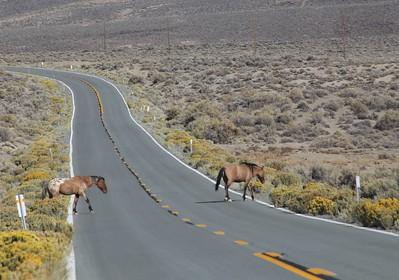BLM to remove wild horses for public and animal safety along highway near Cedarville, Calif.
Organization:
BLM Office:
Media Contact:
ALTURAS, Calif. –The Bureau of Land Management plans to capture and remove up to 25 wild horses from the Carter Reservoir Herd Management Area, which are posing dangers as they roam in search of food and water along California State Route 299, east of Cedarville.
“These horses are a safety hazard to high-speed traffic on the highway and are themselves in danger,” said Craig Drake, manager of the BLM Applegate Field Office. “We must take action to protect public health and safety and to protect the animals.”
The agency will use a bait and water trap, which is a corral with a gate that self closes after the horses enter to eat or drink. The horses will be taken to a BLM preparation facility where they will be available for placement in private ownership through the BLM adoption and sales program.
The Carter Reservoir Herd Management Area covers nearly 24,000 acres along the California-Nevada border. Most of the HMA is within Washoe County, Nevada. Many wild horse adopters prize Carter Reservoir horses for the dun coloration and markings.
The BLM’s decision and a categorical exclusion required under the National Environmental Policy Act are available on the BLM’s online planning site: https://eplanning.blm.gov/eplanning-ui/project/2016306/510.
The BLM protects wild horses and burros, controlling their populations under provisions of the Wild and Free Roaming Horses and Burros Act. The law recognizes the animals as “living symbols of the historic and pioneer spirit of the West,” and requires that they be managed as part of a “thriving natural ecological balance on the range.”
The BLM manages about 245 million acres of public land located primarily in 12 western states, including Alaska, on behalf of the American people. The BLM also administers 700 million acres of sub-surface mineral estate throughout the nation. Our mission is to sustain the health, diversity, and productivity of America’s public lands for the use and enjoyment of present and future generations.

